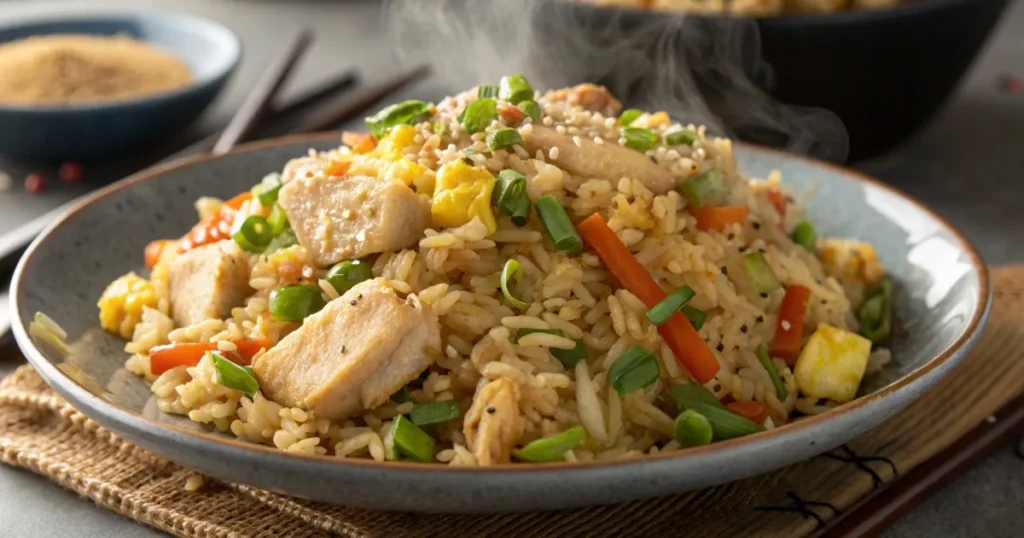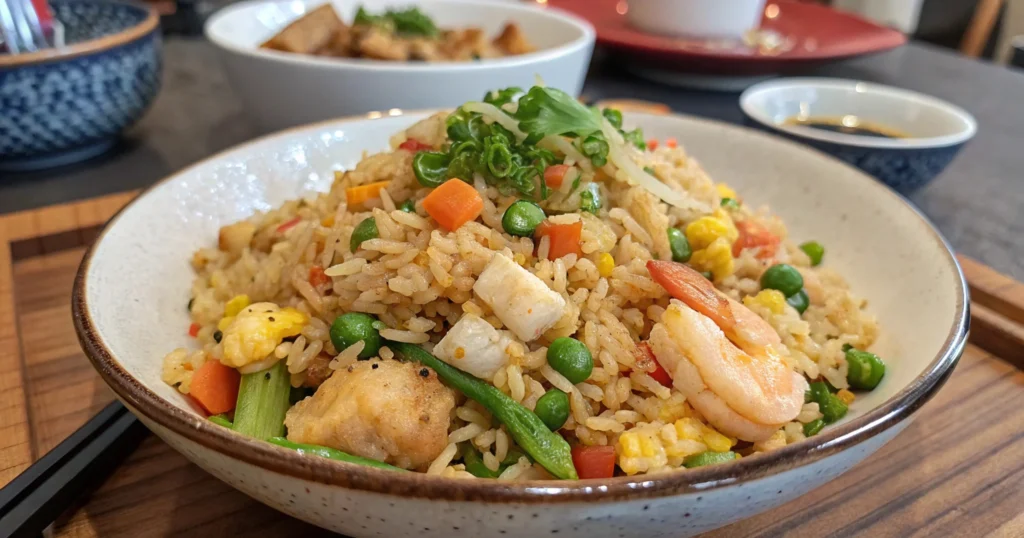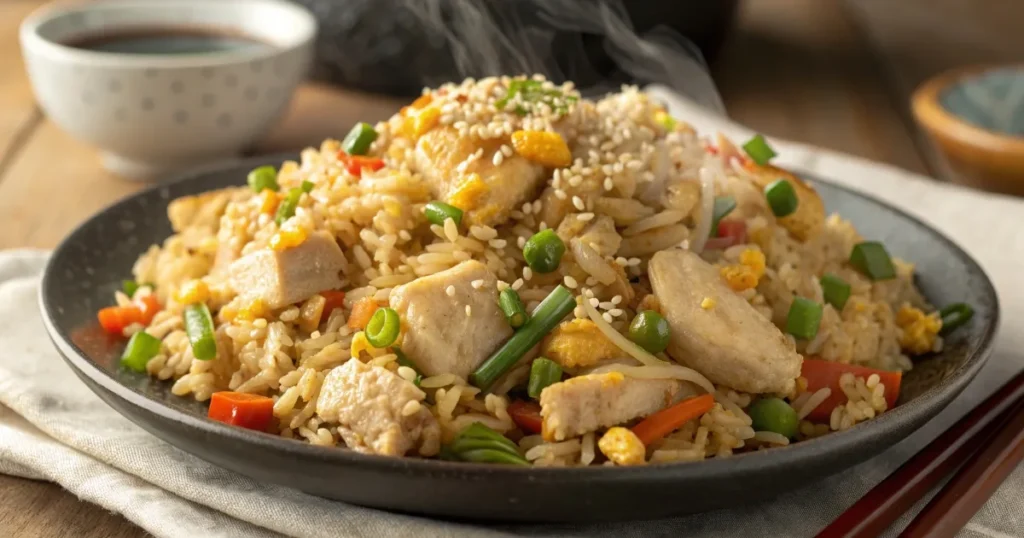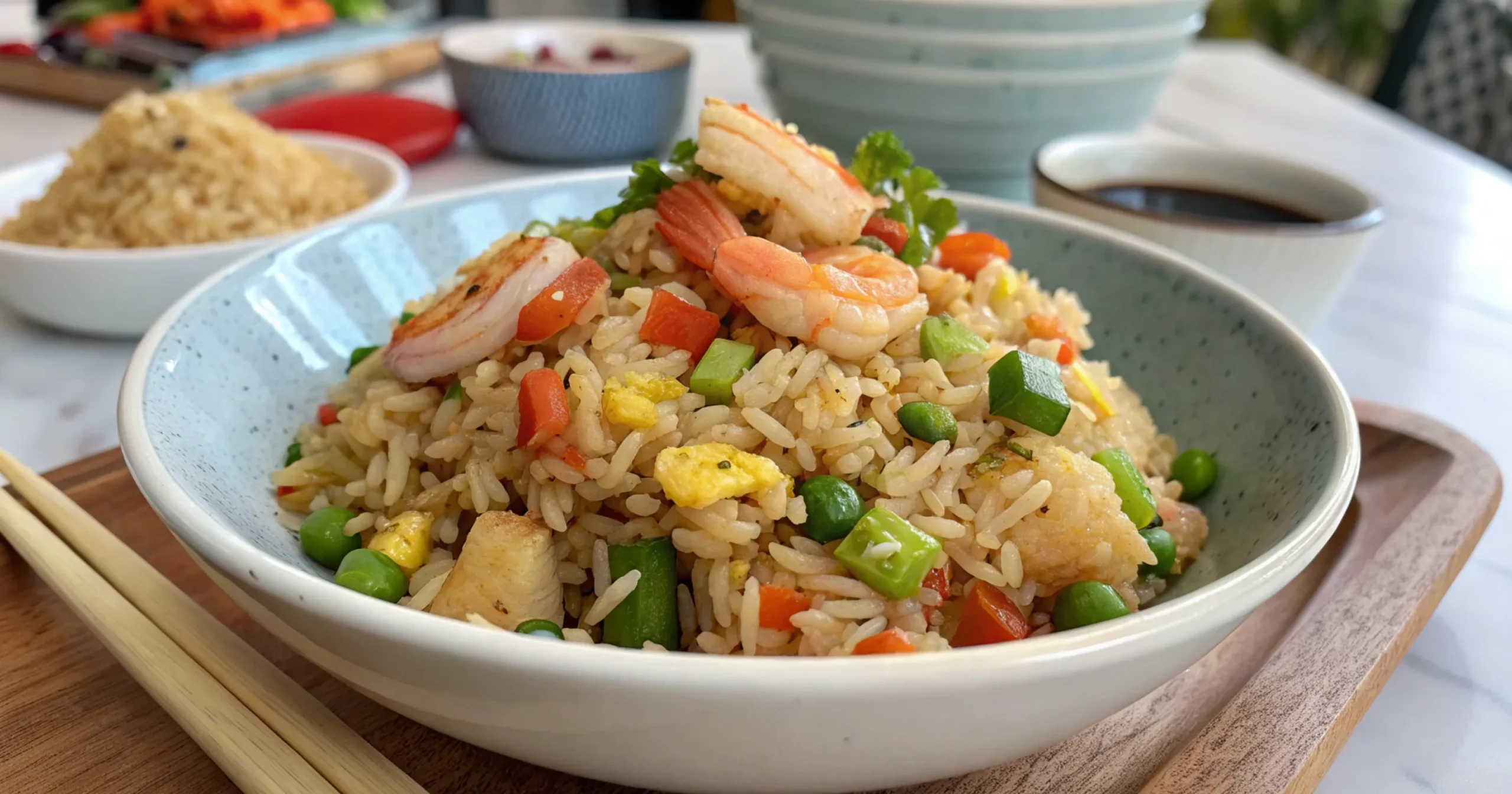Fried rice is a dish that tantalizes taste buds with its perfect balance of flavors, textures, and aromas. But what sets restaurant fried rice apart from homemade versions? Is it the skill of the chef, the equipment used, or perhaps a mystical secret ingredient? In this article, we’ll unravel the mystery behind this beloved dish, exploring techniques, ingredients, and cultural nuances that elevate fried rice to restaurant quality. From the secret ingredient to essential cooking tips, you’ll learn how to master this classic at home.
Let’s dive into the journey of discovering what makes restaurant fried rice so irresistible.

Introduction to Fried Rice Perfection
What Makes Restaurant Fried Rice So Special?
Ever wondered why restaurant fried rice seems to have that extra something that’s hard to replicate at home? It’s not just about the ingredients but also the technique and precision chefs use to create layers of flavor. Each grain of rice feels perfectly coated with seasoning, the vegetables retain their crunch, and there’s a hint of smoky aroma that leaves you craving more.
Restaurant kitchens are equipped with powerful woks and high heat, allowing chefs to achieve wok hei, or the breath of the wok, a hallmark of authentic fried rice. This combination of tools, skill, and a touch of mystery makes every bite taste like magic.
Common Myths About the Perfect Fried Rice
When it comes to recreating fried rice at home, plenty of myths surround the process. Some swear by freshly cooked rice, while others claim it’s all about adding MSG. While these elements may contribute, they don’t guarantee perfection.
The real secret? It’s a combination of the right technique, properly balanced ingredients, and, yes, a special ingredient or two that you’ll soon uncover. By the end of this article, you’ll have a clear roadmap to making restaurant-quality fried rice in your own kitchen.
The Key Secret Ingredient Revealed
Unveiling the Secret Ingredient: What Sets It Apart
So, what is the secret ingredient to restaurant fried rice? Many chefs agree that it isn’t just one thing, but a blend of elements. However, one game-changing addition often used in professional kitchens is oyster sauce. This thick, umami-rich sauce adds depth and a slightly sweet, savory flavor that brings everything together. Some restaurants also rely on MSG for an extra punch of flavor, while others sprinkle a little sugar to balance the saltiness of soy sauce.
Beyond these, chefs often add aromatic ingredients like sesame oil or garlic-infused oil to give the dish that restaurant-quality touch. These little extras may seem minor, but they can completely transform your fried rice. The secret isn’t always about what’s visible—it’s about what lingers on your taste buds.
The Role of Aromatics and Seasonings in Enhancing Flavors
Seasonings and aromatics play a huge role in fried rice. While oyster sauce is a standout secret, combining it with soy sauce creates a rich, umami base. Adding fresh minced garlic, ginger, and scallions in the initial stages of cooking releases fragrant oils that infuse every grain of rice.
Don’t forget the final touch: a few drops of toasted sesame oil at the very end of cooking. This step amplifies the flavors without overpowering the dish. It’s the little things, like timing and balance, that elevate fried rice from ordinary to extraordinary. By using these secrets, you can achieve that restaurant-like depth in your own kitchen.
Essential Techniques Behind Perfect Fried Rice
The Importance of Day-Old Rice
Here’s the first golden rule: always use day-old rice. Freshly cooked rice is too moist and sticky, often clumping together in the pan. Restaurants always use cold, leftover rice because its texture has dried out just enough to separate into individual grains. This ensures that every grain gets evenly coated with seasoning during cooking.
If you don’t have leftover rice, you can spread freshly cooked rice on a tray, cool it quickly in the fridge, and let it dry for a few hours. This quick trick mimics the texture of day-old rice, so you can still enjoy great results.
Mastering the Wok Hei
Ah, wok hei—that elusive smoky flavor in fried rice that’s almost impossible to replicate at home. Achieving wok hei requires intense heat, quick movements, and a seasoned wok. At high temperatures, the oil and ingredients caramelize, creating the signature charred aroma.
For home cooks, the trick lies in preheating your wok or pan until it’s almost smoking. Use a neutral, high-heat oil like peanut or vegetable oil, and stir-fry quickly to prevent overcooking. Don’t overcrowd the pan; cooking in small batches helps maintain the heat and achieve that iconic flavor.
Proper Use of Ingredients: Order and Timing
Another secret to fried rice success is knowing when to add each ingredient. Start with aromatics like garlic and ginger to infuse the oil. Then, add protein and vegetables, stir-frying them separately to maintain their texture. Once these are cooked, push them to the side of the pan, crack in an egg, and scramble it directly in the wok.
Finally, toss in the rice, breaking up any clumps as you go, and mix everything together. Finish with soy sauce, oyster sauce, and a drizzle of sesame oil. This layering of flavors ensures that every bite is well-seasoned and delicious.

Variations in Fried Rice Across Cultures
Chinese vs. Japanese Fried Rice: Key Differences
When you think of fried rice, the Chinese variety probably comes to mind first. However, Japanese fried rice, known as “yakimeshi,” has its own unique take. Chinese fried rice, often cooked with long-grain jasmine rice, features bold flavors from soy sauce, oyster sauce, and sesame oil. In contrast, Japanese fried rice typically uses short-grain rice, giving it a stickier texture. The seasoning is lighter, often featuring soy sauce sparingly and focusing more on the ingredients’ natural flavors.
Both styles are delicious but distinct. Chinese fried rice often includes hearty additions like char siu pork, shrimp, and eggs. Japanese fried rice, on the other hand, might use subtle ingredients like pickled vegetables or even a touch of sake for a fragrant twist.
Popular Regional Variants and Their Unique Ingredients
Fried rice is a global phenomenon with countless regional variations. Thai fried rice, for instance, stands out with its tangy flavor, thanks to lime juice and fish sauce. Indonesian nasi goreng adds a spicy kick with sambal chili paste and often features a fried egg on top.
Even in China, fried rice changes by region. In Yangzhou, the signature Yangzhou fried rice includes finely diced meats and a colorful array of vegetables. Meanwhile, Cantonese versions focus on lighter, more delicate flavors. Exploring these cultural spins shows how versatile fried rice can be.
For a creative fried rice recipe, check out the Blackstone Chicken Fried Rice Recipe on Kamala Recipes.
Tips for Recreating Restaurant-Style Fried Rice at Home
Choosing the Right Ingredients
To replicate restaurant-quality fried rice, the ingredients you choose matter. Always start with day-old rice, as it’s firmer and less likely to clump together. Opt for jasmine rice if you want that authentic Chinese flavor, or short-grain rice for a Japanese-inspired version. Fresh vegetables like carrots, peas, and scallions add vibrant color and texture.
For seasonings, use light soy sauce for a hint of saltiness and dark soy sauce for depth. Oyster sauce is the game-changer here, creating a balance of sweet and savory flavors. Don’t forget a dash of white pepper—it’s subtle but essential for that restaurant vibe.
Tools of the Trade
Investing in the right tools can elevate your cooking game. A traditional carbon steel wok is the best choice for fried rice because it retains heat well and allows for fast, even cooking. If you don’t have a wok, a large skillet with a flat base can work too.
Preheat your wok until it’s smoking hot before adding oil. This step is crucial for creating that elusive wok hei. Use a high-smoke-point oil like peanut or canola oil to prevent burning.
Adjusting Seasonings for a Balanced Profile
The secret to perfectly seasoned fried rice is balance. Start with a base of soy sauce and oyster sauce, then taste and adjust. If it’s too salty, add a pinch of sugar to round out the flavors. A final drizzle of sesame oil at the end of cooking enhances the dish with a rich, nutty aroma.
Experiment with adding a splash of rice vinegar or fish sauce to bring out even more depth. And remember, don’t overcrowd the pan—cook in batches if necessary to ensure every grain of rice is perfectly coated and flavorful.
Frequently Asked Questions About Fried Rice
How do Chinese restaurants make fried rice taste so good?
Chinese restaurants achieve their delicious fried rice flavor through high heat cooking in a wok, which imparts a unique smoky aroma called wok hei. They also use day-old rice for the perfect texture and add umami-rich seasonings like soy sauce, oyster sauce, and sesame oil, along with fresh aromatics like garlic, ginger, and green onions.
What is the secret to authentic fried rice?
The key to authentic fried rice lies in:
- Day-old rice – It’s dry, preventing clumps.
- High heat – Ensures quick cooking and distinct flavors.
- Aromatics – Ingredients like garlic, ginger, and scallions build the flavor base.
- Umami seasonings – Soy sauce, sesame oil, and sometimes fish sauce create depth.
- Balanced additions – Eggs, veggies, and meats add texture and variety.
What gives restaurant fried rice its flavor?
The bold flavor comes from:
- Umami seasonings (soy sauce, oyster sauce, or fish sauce).
- High heat wok cooking for smoky undertones.
- Fresh aromatics like ginger, garlic, and green onions.
The combination of savory, salty, and slightly sweet elements makes it irresistible.
Why do you put sugar in fried rice?
A small pinch of sugar balances the salty and umami flavors from soy sauce and other seasonings. It doesn’t make the dish sweet but enhances the overall flavor harmony, making the dish more satisfying.

Conclusion and Final Tips for Mastering Fried Rice
Wrapping Up: The Key to Restaurant-Quality Fried Rice
Fried rice is more than just a quick meal; it’s a canvas for creativity and flavor. To recreate that irresistible restaurant-style fried rice, remember the essentials: day-old rice, the right blend of sauces, and high heat for achieving wok hei. The secret ingredient, whether it’s oyster sauce, a hint of sugar, or garlic-infused oil, is what elevates your fried rice from good to amazing.
For More Delicious Recipes
Ready to take your fried rice game to the next level? Combine the techniques and ingredients shared in this article with your own twists. Whether you prefer a classic Chinese version or want to explore global variations, fried rice offers endless possibilities.
For more inspiration, explore unique recipes like the Blackstone Chicken Fried Rice Recipe at Kamala Recipes. Let your culinary journey begin!

